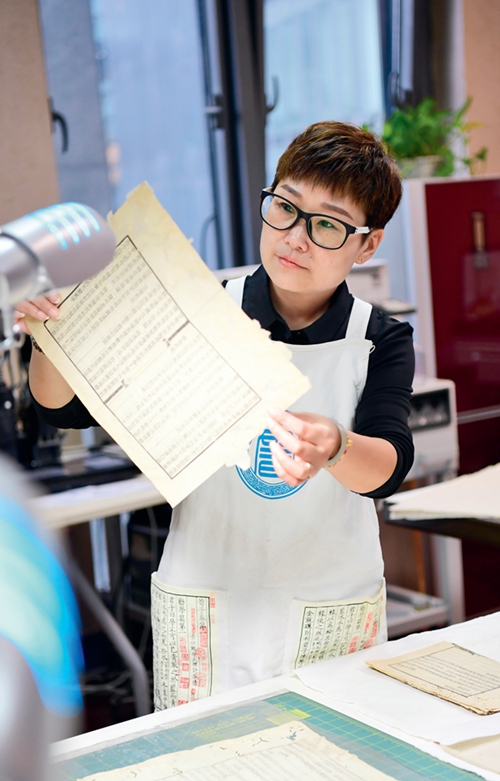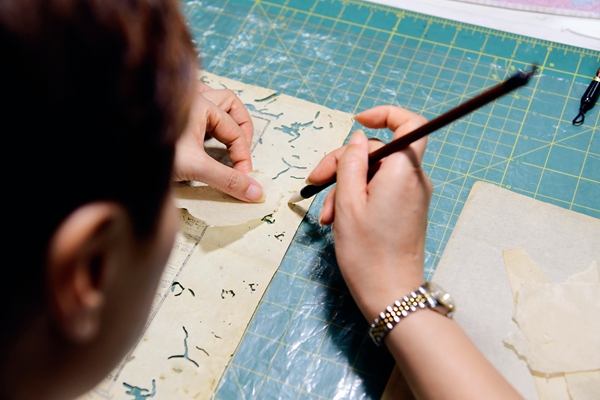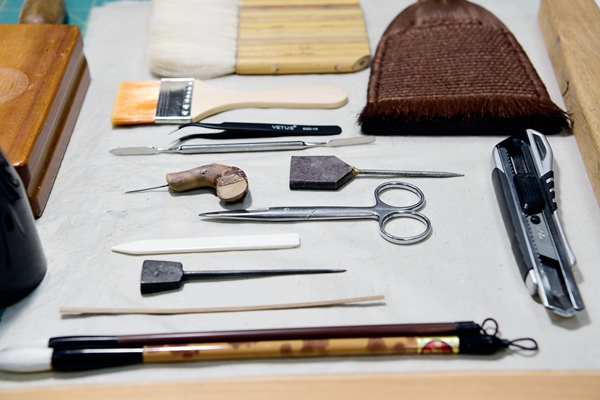
Zhao Ling is at work. [Women of China/Fan Wenjun]
As time goes by, ancient books suffer wear and tear and, in the worst situations, are damaged by worms and/ or gnawed by rats. What can be done to save such valuable books? Ancient-book restorers are able to solve the problem. Zhao Ling, who works at Hangzhou Public Library, is an expert in repairing ancient books. She puts much effort into repairing "weak" ancient books, so they can regain their beauty and be passed on to future generations. Zhao has oft been referred to as a person who "rescues history."
Zhao Ling broadcast live her restoration of an ancient book via a live-streaming platform. Many netizens left online messages indicating they wanted to study ancient-book restoration under Zhao. "The work of repairing ancient books requires the restorer to endure the boredom. When I repair an ancient book, I need to sit still for several hours. I never thought many people would be interested in repairing ancient books," says Zhao.
Studying Book Restoration
Zhao began working on the circulation desk in Hangzhou Public Library, in Hangzhou, capital of eastern China's Zhejiang Province, in 1988, after she graduated from high school. One year later, Zhao went to Shanghai to study ancient-book restoration at Shanghai Library. She had studied how to recognize the versions of ancient books and how to store and repair ancient books in Shanghai for half a year.
After Zhao returned to Hangzhou, she was named the first, and still only, full-time, ancient-book restorer at the library. As a newcomer to ancient-book restoration, it was hard for her to repair the shabby books with crispy paper. So, an expert in mounting and repairing ancient calligraphy and paintings was invited to the library to teach Zhao how to repair ancient books.
There are three stages in ancient -book restoration — separating, repairing and rebinding the book. However, the process of repairing the book involves more than 10 steps. "As a new hand, the step of making paste was a big problem for me. The glue sold in the shop has chemical components. So, I needed to make paste by myself. The first step is to mix flour with water. The second step is to heat the mixture on the stove. I needed to stir the mixture when it was being heated. Then, I had to put the paste in the refrigerator, after it cooled down. When I repaired a book, I dissolved some paste in the boiled water," says Zhao.

Zhao Ling shows how to repair an ancient book. [Women of China/Fan Wenjun]
"The steps of making paste seem simple. However, it is not easy to make good paste. When my teacher taught me how to make paste, he only told me to use two liang (100 grams) of flour, a little alum and the right amount of water. I needed to practice making paste again and again, before I knew the exact amount of alum and water needed … It took me two years to master the skills of making good paste," continues Zhao.
"It (ancient-book restoration) is a little boring. At that time, I asked myself if I wanted to do the work all my life. I thought about going to study cosmetology and hairdressing in Shenzhen. However, my parents stopped me. As I repaired books better and better, my teacher often praised me. When I saw a broken book regain its beauty, I had a sense of accomplishment. The (Chinese) government has paid more and more attention to the protection of ancient books since 2007. It is fortunate that I did not give up repairing ancient books," recalls Zhao.

The tools of repairing ancient books [Women of China/Fan Wenjun]
Becoming an Expert
There are more than 40,000 ancient books in Hangzhou Public Library. Of those, more than 5,000 books are rare editions. The valuable books are well-preserved in boxes in the stack room. The boxes are moth proof, with the smell of camphorwood fragrance. The lamplight in the room is a special yellow light. The temperature in the room is between 20 -25 C, so the books can be maintained for a longer time. "I have the entrance card, and our department's director has the key. Only if the director and I are present, can we open the door," says Zhao.
Books published before 1911 are considered ancient. Books published between 1911-1949 are called ancient books of the Republic of China. "There is a common saying that paper can last for 1,000 years. Only handmade paper, without any chemical materials, can be kept for a long time. Machine-manufactured paper, with chemical additives, becomes yellow and crispy easily, as time goes by. Most of the ancient books of the Republic of China were published with machine- manufactured paper. It is more difficult to repair ancient books of the Republic of China," Zhao says.
The climate also affects paper. The weather in northern China is dry, so the paper in ancient books becomes crispy easily. The weather in southern China is moist, so the paper is easily damaged by worms.

Zhao Ling shows how to repair an ancient book. [Women of China/Fan Wenjun]
"I need to detect the material of the paper of an ancient book before I repair it. In the past, I checked the material of the paper with both my hands and eyes. Now, I can detect the material of the paper by equipment. Then, I select the paper to use to repair the book. The paper should be made with the same materials as the paper in the ancient book. I also dye the selected paper yellow, which is close to the yellow paper of the ancient book," Zhao says.
Hangzhou Public Library has many professional ancient-book repairing machines. However, Zhao still prefers to repair books by hand. Zhao can repair seven or eight pages in a day. Generally, it takes her nearly a month to repair a whole book.
"I have worked as an ancient-book restorer for 20 years. For me, the happiest thing is completing the restoration of a whole book. I will have a sense of accomplishment. Repairing ancient books is 'rescuing history.' The ancient books cannot be passed on to future generations if we do not repair them. In fact, ancient-book repairing is a job that benefits our offspring," says Zhao.

Zhao Ling is at work. [Women of China/Fan Wenjun]

